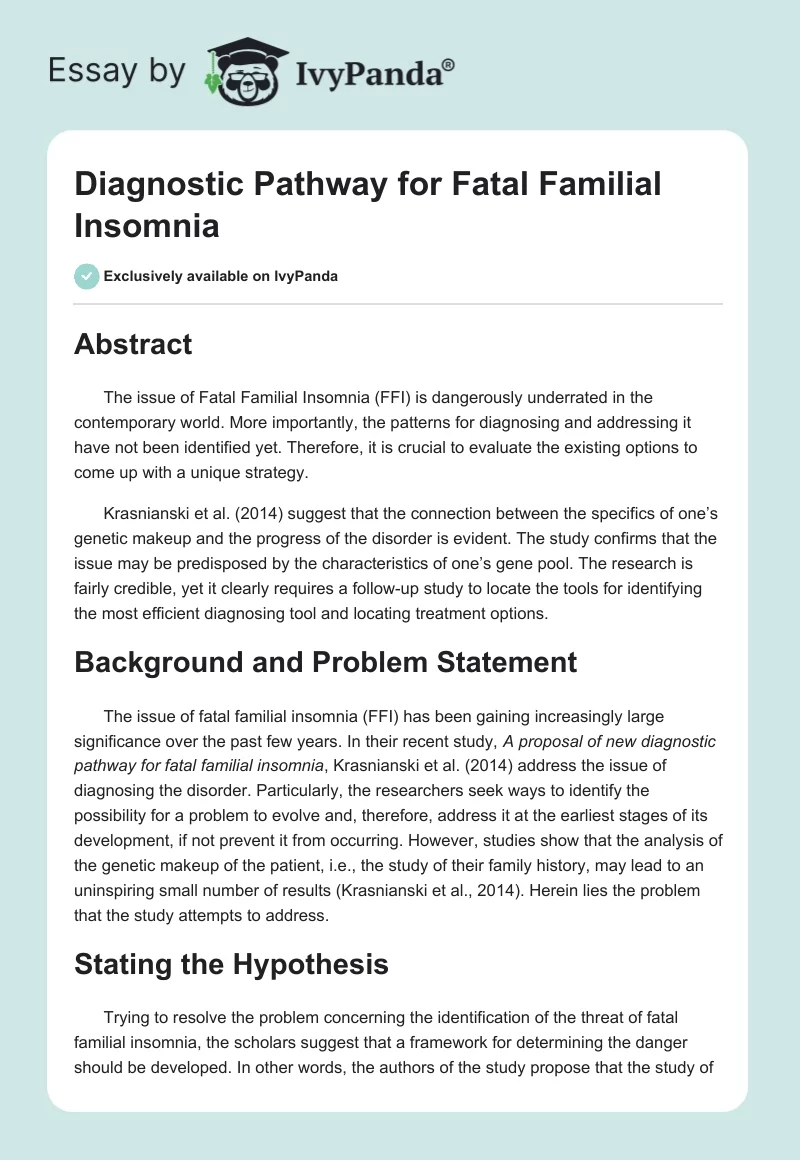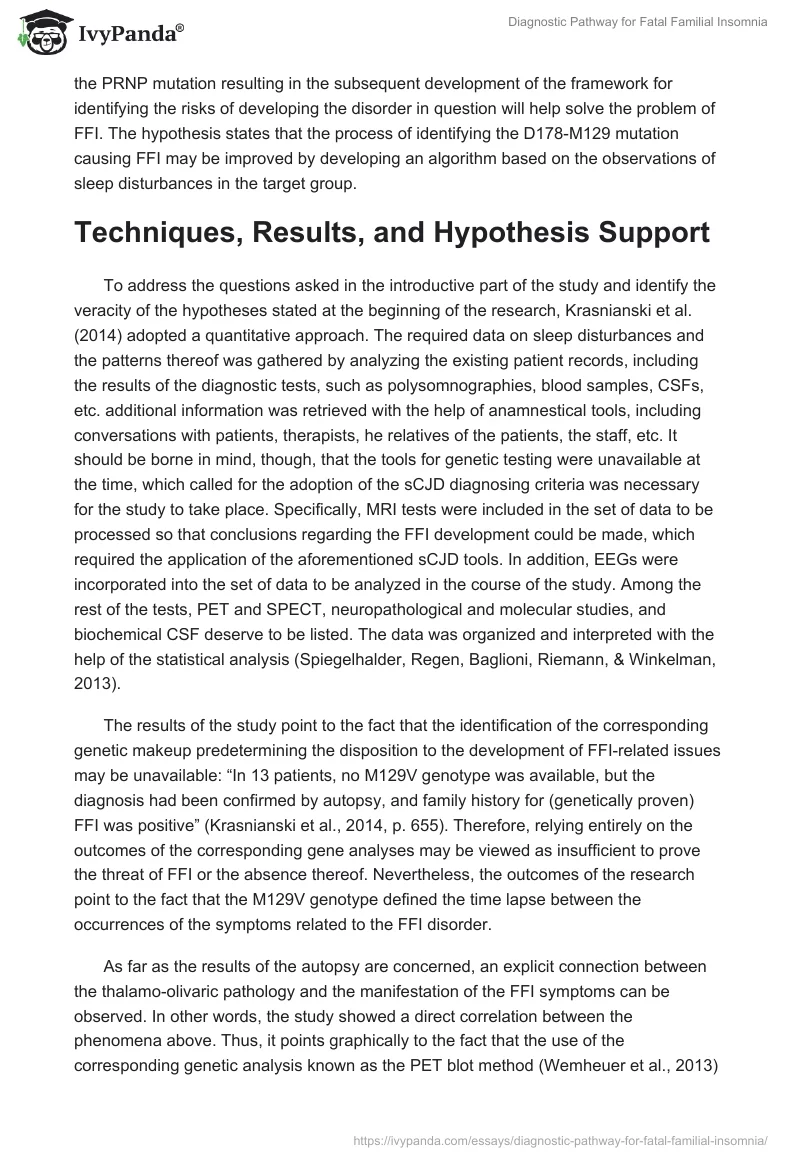Abstract
The issue of Fatal Familial Insomnia (FFI) is dangerously underrated in the contemporary world. More importantly, the patterns for diagnosing and addressing it have not been identified yet. Therefore, it is crucial to evaluate the existing options to come up with a unique strategy.
Krasnianski et al. (2014) suggest that the connection between the specifics of one’s genetic makeup and the progress of the disorder is evident. The study confirms that the issue may be predisposed by the characteristics of one’s gene pool. The research is fairly credible, yet it clearly requires a follow-up study to locate the tools for identifying the most efficient diagnosing tool and locating treatment options.
Background and Problem Statement
The issue of fatal familial insomnia (FFI) has been gaining increasingly large significance over the past few years. In their recent study, A proposal of new diagnostic pathway for fatal familial insomnia, Krasnianski et al. (2014) address the issue of diagnosing the disorder. Particularly, the researchers seek ways to identify the possibility for a problem to evolve and, therefore, address it at the earliest stages of its development, if not prevent it from occurring. However, studies show that the analysis of the genetic makeup of the patient, i.e., the study of their family history, may lead to an uninspiring small number of results (Krasnianski et al., 2014). Herein lies the problem that the study attempts to address.
Stating the Hypothesis
Trying to resolve the problem concerning the identification of the threat of fatal familial insomnia, the scholars suggest that a framework for determining the danger should be developed. In other words, the authors of the study propose that the study of the PRNP mutation resulting in the subsequent development of the framework for identifying the risks of developing the disorder in question will help solve the problem of FFI. The hypothesis states that the process of identifying the D178-M129 mutation causing FFI may be improved by developing an algorithm based on the observations of sleep disturbances in the target group.
Techniques, Results, and Hypothesis Support
To address the questions asked in the introductive part of the study and identify the veracity of the hypotheses stated at the beginning of the research, Krasnianski et al. (2014) adopted a quantitative approach. The required data on sleep disturbances and the patterns thereof was gathered by analyzing the existing patient records, including the results of the diagnostic tests, such as polysomnographies, blood samples, CSFs, etc. additional information was retrieved with the help of anamnestical tools, including conversations with patients, therapists, he relatives of the patients, the staff, etc. It should be borne in mind, though, that the tools for genetic testing were unavailable at the time, which called for the adoption of the sCJD diagnosing criteria was necessary for the study to take place. Specifically, MRI tests were included in the set of data to be processed so that conclusions regarding the FFI development could be made, which required the application of the aforementioned sCJD tools. In addition, EEGs were incorporated into the set of data to be analyzed in the course of the study. Among the rest of the tests, PET and SPECT, neuropathological and molecular studies, and biochemical CSF deserve to be listed. The data was organized and interpreted with the help of the statistical analysis (Spiegelhalder, Regen, Baglioni, Riemann, & Winkelman, 2013).
The results of the study point to the fact that the identification of the corresponding genetic makeup predetermining the disposition to the development of FFI-related issues may be unavailable: “In 13 patients, no M129V genotype was available, but the diagnosis had been confirmed by autopsy, and family history for (genetically proven) FFI was positive” (Krasnianski et al., 2014, p. 655). Therefore, relying entirely on the outcomes of the corresponding gene analyses may be viewed as insufficient to prove the threat of FFI or the absence thereof. Nevertheless, the outcomes of the research point to the fact that the M129V genotype defined the time lapse between the occurrences of the symptoms related to the FFI disorder.
As far as the results of the autopsy are concerned, an explicit connection between the thalamo-olivaric pathology and the manifestation of the FFI symptoms can be observed. In other words, the study showed a direct correlation between the phenomena above. Thus, it points graphically to the fact that the use of the corresponding genetic analysis known as the PET blot method (Wemheuer et al., 2013) is essential to the identification of the disorder and the location of the tools that may assist in the process. The approach in question is often juxtaposed with conventional immunohistochemical staining tools (Peng, Zhang, Dong, & Lu, 2015), yet the latter have proven to lack accuracy in locating the disorder and, therefore, should be discarded as the means of detecting the development of FFI. Similarly, the significance of diagnostic tests is not to be underrated when it comes to locating the possibility of the disorder development, the research outcomes show quite graphically that the adoption of the above techniques leads to a more accurate identification of the threat of FFI development in a patient. The use of the family history turned out to have a surprisingly low relevance in the specified situation. While the outcomes of the analysis showed that the factor above affected the development of the disorder in 10 cases out of 29 (approximately 34.5%), the percentage of cases displaying the connection is rather low.
The hypothesis, in its turn, can be considered proven. The study has revealed that there is, in fact, a pattern in the correlation between sleep disturbances and the neurological symptoms that patients display at the earliest stages of FFI development. Seeing that the sensitivity rates in the target group reached 90%, the outcomes of the research can be considered rather credible.
Results Significance and Possibilities for a Follow-Up Study
The importance of the results can hardly be overrated. As it has been stressed above, the rates of FFI have been getting increasingly high. Although the issue does not get as much interest as the health concerns related to diabetes, cancer, AIDS, etc., it remains one of the deadliest disorders and the greatest threats to the wellbeing of people all over the world. Moreover, the lack of control over the development of the disorder can be viewed as a rather disturbing characteristic of the current situation. Therefore, shedding some light on the issue of the disorder development and identifying the pathways for diagnosing FFI at the earliest stages of its development are crucial steps on the way to defeating the disease and providing patients with a cure. The outcomes of the study, however, call or a follow-up analysis identifying the elements of the framework to be adopted to the diagnosing process.
Reasons for Choosing the Article
Although the phenomenon of insomnia as been studied rather well over the past few years, the problem has always attracted me as the issue that could be addressed in a more efficient manner. With the problems such as diabetes types I and II, cancer, and AIDS, the issue of fatal familial insomnia has been glanced over in both media and contemporary research. I believe that though considered incurable nowadays, it can be treatable one day as long as researchers all over the world join their efforts and keep trying consistently to solve the problem.
Reference List
Krasnianski, A., Juan, P. S., Ponto, C., Bartl,M., Heinemann, U., Varges, D., Schulz-Schaeffer, W. J., Kretzschmar, H. A., & Zerr, I. (2014). A proposal of new diagnostic pathway for fatal familial insomnia. Journal of Neurology, Neurosurgery & Psychiatry, 85(8), 654–659.
Peng, B., Zhang, S., Dong, D., & Lu, Z. (2015). Clinical, histopathological and genetic studies in a case of fatal familial insomnia with review of the literature. International Journal of Clinical and Experimental Pathology, 8(9), 10171-10177.
Spiegelhalder, K., Regen, W., Baglioni, C., Riemann, D. J., & Winkelman, W. (2013). Neuroimaging studies in insomnia. Current Psychiatry Reports, 15(11), 405-411.
Wemheuer, W. M., Wrede, A., Gawinecka, J., Zerr, I., Schulz, W. J., & Schaeffer, E. (2013). Filtration of protein aggregates increases the accuracy for diagnosing prion diseases in brain biopsies. Journal of Neuropathology and Experimental Neurology, 72(8), 758-767.


